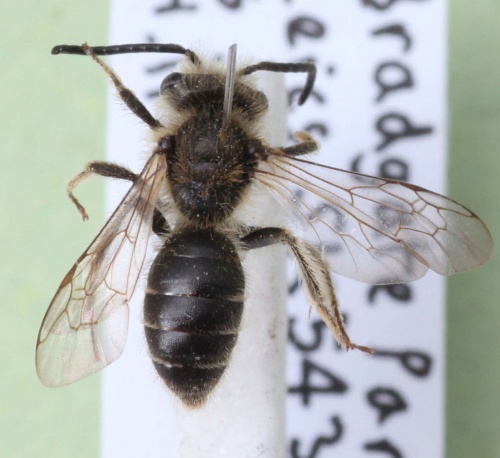Andrena ovatula
Length 7 to 11 mm. This is a small, dark species of solitary mining bee. There are several similar species and detailed examination is necessary. The females are the easiest sex to identify. The hind margin of tergite 3 with a complete band in fresh individuals (broken in wilkella and similis), the band on tergite 4 much broader than wilkella and similis and hairs at tip of abdomen dusky brown rather than orange-brown.
Most solitary bees and wasps are difficult to identify, and can rarely be identified from photos taken in the field. All red-rated records should include a photo or set of photos of the specimen, illustrating the key characters taken from a standard key, which should also be referenced (e.g. ‘Falk, 2015’). The full set of key characters are generally not visible in field photos and photos are rarely sharp enough. To aid in the verification of your records, please include face shot, side, top and wings. The notes should state whether male or female, and explain how the specimen met the key characters. Although NS may not be able to identify the species even if these reference photos are provided, the photos will be stored with the record and may allow it be identified in future. Alternatively, NS will accept records identified by a recognised local or national expert, or that have been identified via BWARS’ Facebook https://www.facebook.com/profile.php?id=100065021433202 . If you have obtained this advice, please note the name of the person/organisation identifying the record in the ‘determiner’ field (e.g. ‘Stuart Roberts, BWARS Facebook’) rather than just a comment of ‘BWARS Facebook’.
Various habitats including hedgerows, flower meadows and post industrial areas.
Usually seen between April and July but occasionally through to September.
Feed on the pollen of various flowers.
Mainly a southern species in Britain with most records concentrated along the south coast of England.
Rare in Leicestershire and Rutland. The Bradgate Park record of 6th June 2013 was the first record of this species in VC55.
Leicestershire & Rutland Map
Enter a town or village to see local records
MAP KEY:
Yellow squares = NBN records (all known data)
Coloured circles = NatureSpot records: 2020+ | 2015-2019 | pre-2015
UK Map
Species profile
- Common names
- Small Gorse Mining Bee
- Species group:
- Bees, Wasps, Ants
- Kingdom:
- Animalia
- Order:
- Hymenoptera
- Family:
- Andrenidae
- Records on NatureSpot:
- 2
- First record:
- 06/06/2013 (Ikin, Helen)
- Last record:
- 26/07/2023 (Nicholls, David)
Total records by month
% of records within its species group
10km squares with records
The latest images and records displayed below include those awaiting verification checks so we cannot guarantee that every identification is correct. Once accepted, the record displays a green tick.
In the Latest Records section, click on the header to sort A-Z, and again to sort Z-A. Use the header boxes to filter the list.


